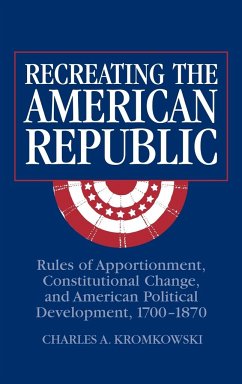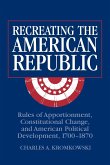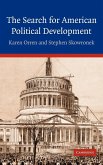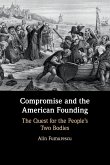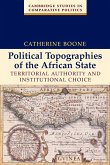Rules of apportionment are elements of social and political order. In social gatherings, families and governments they assume a variety of written and unwritten forms and in every order they determine not only how collective decisions are made but also how and why a particular constitutional order develops over time. Recreating the American Republic provides a far-reaching analysis of when, how and why these rules change and with what consequences. Recreating the American Republic reveals the import of these rules of apportionment by engaging the three most widely recognized and studied eras and events of American political history: the Colonial era and the American Revolution; the early national years and the 1787 Constitutional Convention; and the nineteenth century and the American Civil War. Recreating the American Republic systematically compares each seemingly familiar era and event - revealing new insights and a new metanarrative of American political development between 1700 and 1870.
Table of contents:
1. Introduction; 2. Raising leviathan: British-American relations, 1700-1774; 3. Our emperors have no clothes: the macro-micro synthesis and the American Revolution; 4. Union over multiplicity: a bond of words, a confederation in speech, and the constitutional rule of equal state apportionment; 5. Contours of the confederation: macro-level conditions, 1776-1786; 6. Divide et impera: constitutional heresthetics and the breaking of the articles; 7. The veil of representational certainty: the 1787 constitutional convention; 8. The relational republic: macro-level conditions, 1790-1860; 9. Between consent and coercion: libido dominandum and the end of representation; 10. Conclusions.
Political historians recognize the colonial years and the American Revolution, the early national era and the 1787 Constitutional Convention, the nineteenth century and the American Civil War as the three most important eras in American history. Recreating the American Republic offers the first comparative historical analysis and synthesis of these.
The first comparative historical analysis of the three most important eras of American history.
Hinweis: Dieser Artikel kann nur an eine deutsche Lieferadresse ausgeliefert werden.
Table of contents:
1. Introduction; 2. Raising leviathan: British-American relations, 1700-1774; 3. Our emperors have no clothes: the macro-micro synthesis and the American Revolution; 4. Union over multiplicity: a bond of words, a confederation in speech, and the constitutional rule of equal state apportionment; 5. Contours of the confederation: macro-level conditions, 1776-1786; 6. Divide et impera: constitutional heresthetics and the breaking of the articles; 7. The veil of representational certainty: the 1787 constitutional convention; 8. The relational republic: macro-level conditions, 1790-1860; 9. Between consent and coercion: libido dominandum and the end of representation; 10. Conclusions.
Political historians recognize the colonial years and the American Revolution, the early national era and the 1787 Constitutional Convention, the nineteenth century and the American Civil War as the three most important eras in American history. Recreating the American Republic offers the first comparative historical analysis and synthesis of these.
The first comparative historical analysis of the three most important eras of American history.
Hinweis: Dieser Artikel kann nur an eine deutsche Lieferadresse ausgeliefert werden.
